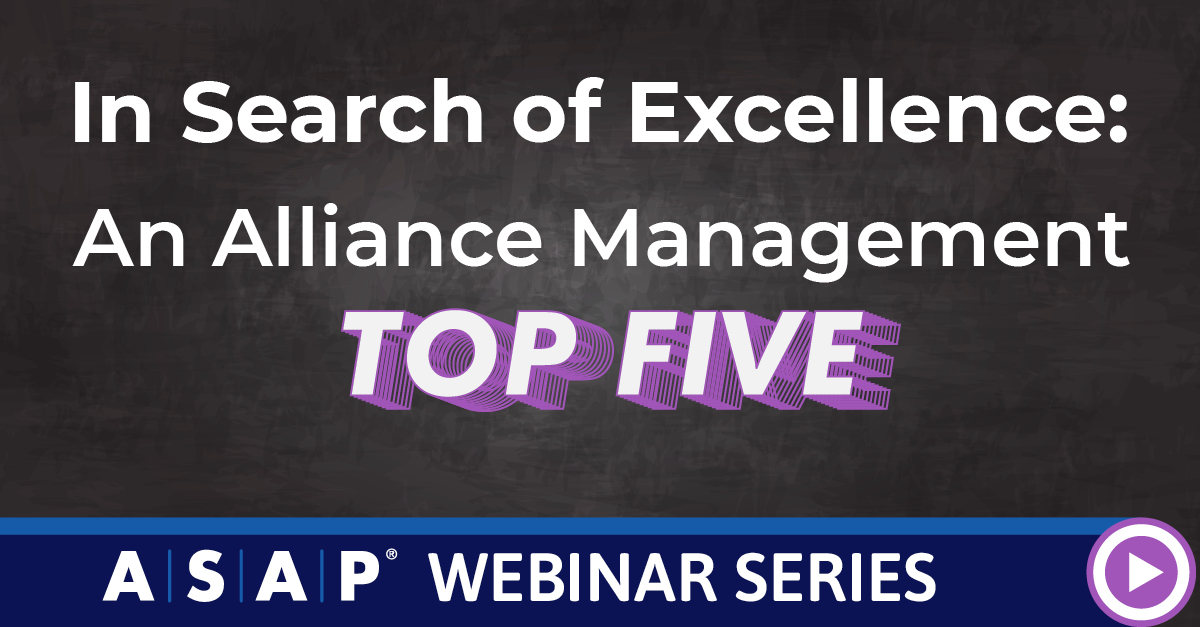In Search of Excellence: An Alliance Management Top Five
All of us would probably like to think we’re working and striving toward excellence every day, in every way. But are we? And how can we know?
For alliance managers, fortunately, there are some ways to “measure what matters” and find out. That was the clarion call of Jan Twombly, CSAP, and Jeff Shuman, CSAP, PhD, principals of The Rhythm of Business, in their February ASAP webinar, “Top Five Opportunities for Alliance Management Excellence: Getting a Little Better Every Day.”
Shuman started off by stressing that “excellence is not a skill, it’s a mindset.” And what differentiates great alliance managers from the merely good ones, he said, is that “the great ones strive for excellence in everything they do, getting a little better every day.” He also pointed out that if you’re truly getting even a tiny bit better every day at something—say, alliance management—then this accumulation of excellence will pile up exponentially: something like compound interest.
Based on two years’ worth of assessments of relatively complex alliances and their practices, Twombly and Shuman have defined some of the ways in which what they call “leading” alliances outstrip those that are “developing” or merely “emerging”—leading alliances performed up to 30 percent better than emerging ones.
A Quintet of Opportunities
They also identified the top five opportunities for alliance managers to focus on as they try to get a little better every day. They are:
- Follow the North Star: strategic visioning on the purpose of the alliance and what constitutes “goodness”
- Deploy efficient operating models—workflows, roles and responsibilities, onboarding processes, and overall execution
- Establish agile governance processes—featuring optimized and flexible norms, work styles, and clearly defined roles for governance committee members
- Create alignment so that everyone has a “common language with shared meaning”
- Communication, communication, communication: everyone in the alliance has a “single version of the truth,” according to Twombly
As Twombly noted, “Effective alliance managers are able to manage the cost of time,” and they differ from their peers in that “the others have to fight upstream.” This of course is made worse by organizations that are not especially partnering-ready or -friendly. By contrast, organizations that do alliances well make optimum use of resources, decision making, communication, stakeholder alignment, and other components of the collaborative process—plus they tend to feature a “one-team mentality” in their alliances such that an outsider might not be able to differentiate between one company and the other in an alliance.
How to Avoid the Burden of “This Is Just Too Hard”
The alliances that don’t do so well, according to both Twombly and Shuman, tend to be plagued by problems involving executive leadership, poorly executed decision-making processes, and overall a burdensome sense of burnout and stress, such that, even if the alliance is bringing in revenue, said Twombly, people complain wearily that “this is just too hard.”
Shuman stressed balancing a long-term perspective with understanding the importance of netting quick wins from an alliance, adding that “the longer term today has gotten shorter than it used to be.”
He concluded by saying that “attitude is everything,” then challenged the ASAP audience: “What’s your plan to get a little better every day?”
If you’re looking to get more of these great alliance insights from Twombly and Shuman, the upcoming ASAP Global Alliance Summit will feature one of their master classes, “Helping Your Partners Help You: Using the Power of Positive Influence,” as well as an executive panel discussion on biopharma commercial alliances moderated by Twombly. Go to www.asapsummit.org for more information and to register.


